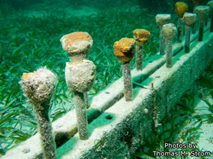by Jon Dorsey, RJD Intern
Climate change is a major concern that has been facing humankind for quite some time. Sea surface temperatures are predicted to rise between 1 – 6 degrees Celsius by 2100 and the consequences of this world-wide climate alteration include a loss of species richness, habitat shifts, and certain species endangerment. To measure the potential changes in habitat shifts of marine predators, the Tagging of Pacific Predators (TOPP) program designed an experiment where they would tag different Pacific marine predator species and track their behavior and migration patterns from 2000 – 2009. Along with the species tracking, they used functions of sea surface temperatures, chlorophyll A, and bathymetries to consolidate models that could allow the prediction of major marine predator habitat changes up until the year 2100. With this collected data, baselines would be set for which species require special management and which critical ecosystems are most at risk.

This diagram depicts the relative densities of top predators from 2001 -2009 In the Eastern Pacific Ocean.
The TOPP program chose to follow top predators because of the essential role they play in their environments. These predators provide a system of top-down control of ocean food webs and chains. Therefore, when a species is removed due to an environmental change, the stability of that marine ecosystem is jeopardized due to the resulting changes in the trophic cascade. The TOPP program collected sufficient results from 15 predator species and analyzed their individual tracks. Patterns in biodiversity indicated a northward movement in the core habitat, as a result of the northward swing of the NPTZ (North Pacific Transition Zone) and the richness decreased by 20%. In order to acclimate to these habitat shifts, predators were forced to live in unfamiliar environments in which not all of the species adapted well.
Predators within the shark, marine mammal, and turtle guilds have all shown declines in their new potential core habitats. The shark guild showed the most radical pelagic habitat loss with 3 out of every 4 species showing declines. Other species such as loggerhead turtle and blue whales also exhibited declines in their core habitats. One potential explanation is that these species have a lower capacity for adaptation due to their specialized diets. Their new environments may not cater to their specific diets which can cause an improper balance of nutrients in their diets. These decreases are alarming and it forces us to come up with potential ways to maintain stable predator populations.

These graphs display the predicted quarterly changes of population density for the tagged marine predators over the next century.
A primary way to maintain a healthy ecosystem should be to implement a system of marine ecosystem conservation and manage it proactively. The effects and rates of how the climate changes will impact different ecosystems will not be uniform. Therefore, it is crucial that we identify biodiversity hotspots that are at risk. Due to the shifting habitats, protected areas that would be oriented to transient oceanic features are being proposed. What this means is that areas where eddies, fronts, and upwellings are known to exist will be under a protected law due to the unstable and ever-changing dynamics. Climate change is a phenomenon affecting the whole planet and we must take preventative actions and develop recovery plans to protect the top predators that play vital roles in maintaining equilibrium in the marine environment.
REFERENCES:
Hazel, E et al. (2012). Predicted habitat shifts of Pacific top predators in a changing climate. Nature Climate Change




